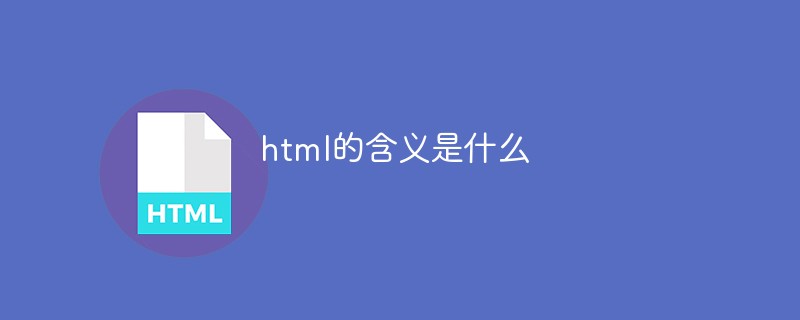
The full English name of
html is Hyper Text Markup Language, which means hypertext markup language; a hypertext document written in HTML is called an HTML document, and it can be independent of various operating system platforms, such as UNIX and Windows. wait.

The operating environment of this article: Windows 7 system, HTML5 version, DELL G3 computer. What does
html mean?
The full English name of HTML is Hyper Text Markup Language, which is hypertext markup language. HTML is a markup language created in 1990 by Tim Berners-Lee, the inventor of the Web, and his colleague Daniel W. Connolly. It is an application of the standard generalized markup language SGML. Hypertext documents written in HTML are called HTML documents, which can be independent of various operating system platforms (such as UNIX, Windows, etc.). Using HTML, the information that needs to be expressed is written into HTML files according to certain rules, recognized by a dedicated browser, and these HTML files are "translated" into identifiable information, that is, the web page you see now.
Since 1990, HTML has been used as the information representation language of the World Wide Web. Files described using HTML need to be displayed through a web browser. HTML is a language for creating web page files. It uses markup instructions (tags) to display images, sounds, pictures, text animations, movies and other content. In fact, every HTML document is a static web page file. This file contains HTML instruction codes. These instruction codes are not a programming language, but a markup structure language that layouts the display position of data in a web page. It is easy to learn. Easy to understand and very simple. The universal application of HTML brought about the technology of hypertext - jumping from one topic to another, jumping from one page to another, and linking files to hosts around the world with the click of a mouse. Hypertext Transfer Protocol provides The rules that browsers follow and the operations they perform when running HTML documents. The formulation of HTTP enables browsers to have unified rules and standards when running hypertext.
A hypermedia document on the World Wide Web (www) is called a page (foreign language: page). The page that is the starting point for an organization or individual on the World Wide Web is called the homepage (foreign language: Homepage) or homepage. The homepage usually includes pointers (hyperlinks) to other related pages or other nodes. The so-called hyperlink is a Uniform Resource Locator (Uniform Resource Locator, foreign language abbreviation: URL) pointer, by activating (clicking) it, the browser can easily obtain new web pages. This is also one of the most important reasons why HTML is widely used. An organic collection of pages that is logically viewed as a whole is called a website (Website or Site). Hypertext Markup Language (English abbreviation: HTML) is a markup language designed for "web page creation and other information that can be viewed in a web browser."
The essence of a web page is hypertext markup language. By combining it with other Web technologies (such as scripting language, public gateway interface, components, etc.), powerful web pages can be created. Therefore, Hypertext Markup Language is the basis of World Wide Web (Web) programming, which means that the World Wide Web is built on hypertext. Hypertext Markup Language is called Hypertext Markup Language because the text contains so-called "hyperlink" points.
[Recommended:HTML video tutorial]
Definition
Hypertext Markup Language is a standard universal markup language An application under , it is also a specification and a standard, which uses mark symbols to mark various parts of the web page to be displayed. The web page file itself is a text file. By adding tags to the text file, you can tell the browser how to display the content (such as how to process text, how to arrange pictures, how to display pictures, etc.). The browser reads the web page files in order, and then interprets and displays the marked content according to the tags. The error will not be pointed out for wrongly written tags, and the interpretation and execution process will not be stopped. The compiler can only analyze the cause of the error through the display effect. and error location. However, it should be noted that different browsers may have different interpretations of the same tag, and thus may have different display effects.
Features
Hypertext markup language document production is not very complicated, but it is powerful and supports the embedding of files in different data formats, which is also popular in the World Wide Web (WWW) One of the reasons is that its main features are as follows:
Simplicity: The hypertext markup language version is upgraded using a superset method, making it more flexible and convenient.
Scalability: The wide application of hypertext markup language has brought about requirements for enhanced functions and added identifiers. Hypertext markup language adopts the method of subclass elements to bring system expansion. to guarantee.
Platform independence: Although personal computers are popular, there are many people who use other machines such as MAC. Hypertext Markup Language can be used on a wide range of platforms. This is also the World Wide Web (WWW) Another reason for its popularity.
Versatility: In addition, HTML is the universal language of the Internet, a simple and universal all-purpose markup language. It allows web page producers to create complex pages that combine text and images, and these pages can be viewed by anyone else on the Internet, regardless of the type of computer or browser used.
The above is the detailed content of What does html mean?. For more information, please follow other related articles on the PHP Chinese website!